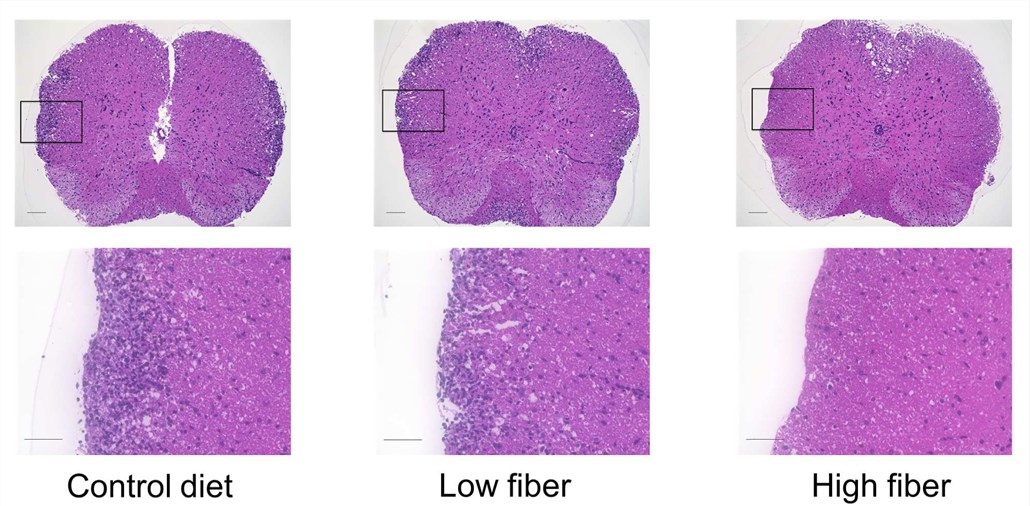MOG35-55 induced EAE Mice Model
Multiple Sclerosis (MS) is a chronic inflammatory neurodegenerative disease of the central nervous system (CNS). Experimental autoimmune encephalomyelitis (EAE) is the most common animal model of human MS as it is especially useful to investigate neuroinflammatory pathways and often serves as a "proof-of-principle" model for the efficacy of novel treatment strategies. At Creative Biolabs, we provide MOG-induced EAE efficacy models (both monophasic and chronic forms) for our clients to facilitate their MS research. Our MOG-induced EAE model is well-characterized and commonly used in the development of a variety of MS therapeutics.
Introduction of MOG
Myelin oligodendrocyte glycoprotein (MOG) is a member of the immunoglobulin superfamily and is exclusively expressed in the CNS on the surface of myelin sheaths and oligodendrocyte processes. The function of MOG is not yet fully understood but synthetic peptide MOG35-55 is discovered to induce autoantibody production and relapsing-remitting neurological disease causing extensive plaque-like demyelination. This autoantibody response to MOG35-55 has been observed in MS patients and MOG35-55-induced EAE C57BL/6 mice and Lewis rats.
Model Description
EAE susceptibility and phenotype are largely dependent on the chosen antigen and rodent strain. Among all the mice strains, C57BL/6 mice are the most commonly used strain for transgenic mouse construction, thus allowing for investigation of the effects of drugs or of particular genes by using transgenic C57BL/6 mice challenged by autoimmune neuroinflammation. For the induction of EAE, typically, the immunogenic epitope MOG35-55 is suspended in complete Freund's adjuvant (CFA) prior to immunization for the immunogenic potential of MOG35-55 is not sufficient to induce disease. One hypothesis says that the injection of CFA can result in prolongation of the presence of antigens and a more efficient transport of these to the lymphatic system. Thereafter, pertussis toxin (PT), suggested to modulate the blood-brain barrier and the immunological responsiveness itself by researchers is applied on the day of immunization and a couple of days later to facilitate the induction of EAE.
Immunization with MOG35-55 in CFA can induce monophasic or a chronic form of EAE. The former is characterized by multifocal, confluent areas of mononuclear inflammatory infiltration and demyelination in the peripheral white matter of the spinal cord. The latter type of EAE shows similar pathology with a reduced tendency to the resolution of inflammation and demyelination after the peak of disease. These characteristics make this disease type a good model of chronic inflammatory demyelination. At Creative Biolabs, we are capable of providing both monophasic and chronic forms of EAE induced by MOG35-55.
Features of MOG35-55-Induced EAE Model
- One of the most widely distributed EAE models and can be considered as a reliable, replicable and well-to-use animal model.
- An ideal model for the preclinical efficacy testing of compounds targeting T cell function.
- Macrophages and CD4+ T cells are the main cell types in the inflammatory infiltrate.
- In the brain, there is meningitis and perivascular inflammatory cuffing in the cerebellum and hindbrain white matter.
 Fig.1 Histopathological assessment of the CNS shows that high-fiber diet ameliorates the disease severity of MOG-induced EAE. Mice were fed a high-fiber, low-fiber or control diet 2 weeks before immunization and throughout the study. (Mizuno et al. 2017)1, 2
Fig.1 Histopathological assessment of the CNS shows that high-fiber diet ameliorates the disease severity of MOG-induced EAE. Mice were fed a high-fiber, low-fiber or control diet 2 weeks before immunization and throughout the study. (Mizuno et al. 2017)1, 2
Assessments
After immunization, mice have to be evaluated daily for changes in weight and clinical symptoms. Moreover, brain samples are processed for histopathological examination and histological evaluation in terms of mononuclear cell infiltration, white matter damage, and demyelination. Briefly, Creative Biolabs is capable of conducting assessments including but not limited to:
- Body weight
- EAE scoring
- Histopathological examination for both inflammation and demyelination
- Biomarker analysis
- Biochemical analysis
Apart from the model described above, Creative Biolabs can offer other EAE models:
The comprehensive list of rodent neurological disease models is listed below for your review:
Creative Biolabs offers an extensive expertise in the preclinical efficacy testing and evaluation of potential therapeutics, including biologics, biosimilars, and small molecules using a wide range of animal disease models closely mimicking human conditions. Contact us with your requirements and enjoy the great value of our services.
References
- Mizuno, M.; et al. The dual role of short fatty acid chains in the pathogenesis of autoimmune disease models[J]. Plos One. 2017, 12(2): e0173032.
- under Open Access license CC BY 4.0, without modification.
For Research Use Only.
